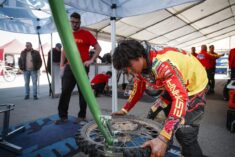 So, what is it that makes the FIM International Six Days of Enduro truly unique? For starters, there is the history – the event is the longest running event on the annual FIM calendar, first run (as the International Six Days Trial – ISDT as it was back then) in Carlisle, England, in 1913. Then there is the fact that it is a team event – the ISDE is a FIM World Championship competition for national teams, with riders’ performances combining to determine a team’s result. And then there are the rules – many aimed at ensuring the ISDE remains a true test of machine, rider skill, and reliability.
So, what is it that makes the FIM International Six Days of Enduro truly unique? For starters, there is the history – the event is the longest running event on the annual FIM calendar, first run (as the International Six Days Trial – ISDT as it was back then) in Carlisle, England, in 1913. Then there is the fact that it is a team event – the ISDE is a FIM World Championship competition for national teams, with riders’ performances combining to determine a team’s result. And then there are the rules – many aimed at ensuring the ISDE remains a true test of machine, rider skill, and reliability.
When it comes to the FIM World Trophy competition, each nation can enter a maximum of four riders with the best three scores used to give combined daily and end-of-event team results. In the FIM Junior World Trophy competition, for riders under twenty-three years of age, three riders are entered per nation with the three best scores used to give combined daily and end-of-event team results. In the FIM Women’s World Trophy competition two rider scores are counted, with the team with the best time getting the victory.
The ISDE runs using what many see as ‘old-school enduro rules’ where only riders are allowed to work on their bikes, once in competition. With team staff allowed to refuel bikes, riders must carry out all essential maintenance themselves. If things go well riders will focus on daily tyre changing, and regular air filter changes. In the event of crashes or technical issues, riders will tackle clutch, piston, handlebar, and suspension work themselves. Each evening all competitor machines are placed in a closed, overnight parc ferme.
Riders get two primary opportunities to work on their bikes – at the start and finish of each day. Ensuring plenty of drama, the work area prior to the start of each day is always filled with busy riders, and plenty of frantic activity. Riders’ bikes must start via mechanical or electric starter and be ridden twenty metres, failure to do so will result in a ten second penalty.
Unquestionably, what makes the ISDE unique is the fact that riders need to be self-sufficient, and have a strong mechanical knowledge, as well as the ability to work on their own bikes. All outside assistance is forbidden, other than the normal servicing given at the official refuelling stations, and to clean the number plates and sponsor stickers with the aid of a cloth or sponge! The expression ‘outside assistance’ refers to the act involved, when any person, other than the rider or an official in the performance of his duty comes into contact with the motorcycle.
So that is why the ISDE remains a true test of machine, rider skill, and reliability.
